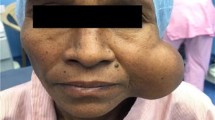Abstract
Salivary gland tumor comprises of approximately 3 to 10% of neoplasms of the head and neck region. Parotid gland is the most commonly involved salivary gland with an incidence of 62% followed by submandibular gland and other minor salivary gland tumors. However clinical course of benign and malignant tumors resemble each other in clinical findings, we require histopatholocal or cytological diagnosis for planning of management. To analyze parotid tumors retrospectively with following objectives. (1) Demographic distribution of parotid tumors. (2) To evaluate cytological and histopathological findings of parotid tumors. (3) Correlation of cytological and histopathological findings of parotid tumors. It was a retrospective observational study involving 31 patients who presented with parotid region swelling. Pre operative FNAC (fine needle aspiration cytology) and post operative histopathology were correlated. Surgical management depended on nature of disease. Correlation of FNAC and Histopathology: among 27 cases pre operative FNAC and post operative histopathology was same and in only 3 cases reports differed. One FNAC was inconclusive. In present study, Sensitivity of FNAC is 81.81%, Specificity is 94.73% and accuracy is 90%. FNAC is usually the first investigative modality, as it is a minimally invasive, cheap, OPD procedure that can differentiate benign from malignant tumors. Knowing preoperative pathological nature of disease can help in planning of surgical process.
Similar content being viewed by others
Avoid common mistakes on your manuscript.
Introduction
Salivary gland diseases are not a major health related issue in a western world however it is quite common in India. Though they account for only less than 2% of human tumors [1], it acquires a particular interest to otolaryngolosists. Salivary gland tumor comprises of approximately 3–10% of neoplasms of the head and neck region [2]. Parotid gland is the most commonly involved salivary gland with an incidence of 62% followed by submandibular gland and other minor salivary gland tumors. Three fourth of parotid tumors are benign. However clinical course of benign and malignant tumors resemble each other in clinical findings, we require histopatholocal or cytological diagnosis for planning of management. The aim of this study was to analyze retrospectively parotid tumors presented to our set up.
Aim
To analyze parotid tumors retrospectively with following objectives.
Objectives
-
1.
Demographic distribution of parotid tumors.
-
2.
To evaluate cytological and histopathological findings of parotid tumors.
-
3.
Correlation of cytological and histopathological findings of parotid tumors.
Materials and Methods
It was a retrospective observational study involving 31 patients who presented with parotid region swelling in outpatient department of otolaryngology of XXXXXXXX between years 2014–2017. After obtaining informed and written consent from all the patients, they underwent a protocol of detailed history, clinical evaluation and cytological finding by means of Fine needle aspiration cytology (FNAC). After words they were posted for surgery depending upon their extent and nature of disease. Entire data of post operative histopathological reports of specimen was collected and correlated with preoperative FNAC results.
Preoperative FNAC
Under aseptic precautions a swelling was palpated and fixed. A 10 cc syringe with 16 gauze needle was introduced into the swelling. The material was aspirated and smeared upon a clean glass slide. The methanol fixed smears were stained with Pap (papanicolau), H&E (Haematoxylin and eosin) and MGG (May Grunwald Giemsa) respectively.
Post Operative Histopathology
All the specimens were subjected to a careful and detailed gross examination, 10% formalin fixed and paraffin embedded tissue sections from these specimens were used for microscopy study. Staining was done by H&E. Results obtained were as: nucleus stained blue and cytoplasm stained pink.
All the data was collected, tabulated and analyzed.
Results
Total 31 patients were included in this study. Most of the patients were from rural area as our hospital is nearby and trusted to the people of rural people. It doesn’t mean that parotid disease is more common in rural area only. It’s mainly because of location of our hospital set up.
Gender distribution: Among total 31 patients, 14 (45%) were women and 17 (55%) were men.

Age distribution: the age ranged from 18 to 83 years with mean of 50 years. Maximum patients were in the age group of 30–40 years.

Clinical findings: 16 patients had swelling on right side, 14 on left side and 1 had bilateral tumors. Facial nerve was involved in 2 of the cases.
FNAC: out of 31 cases, 30 aspirations were conclusive and 1 was inconclusive. Of the 30 aspirations 20 were benign and 10 were malignant. Out of all benign tumors, Benign mixed tumor was most common occurring in 13 (41.93%) cases followed by Warthin’s in 2 (6.45%) cases. In malignant lesions Squammous cell carcinoma was commonest occurring in 5 (16.12%) of total cases. One aspiration was inconclusive.

Histopathology: Out of 31 cases 19 (62%) were benign and 12 (38%) were malignant.

Correlation of FNAC and Histopathology: among 27 cases pre operative FNAC and post operative histopathology was same and in only 3 cases reports differed. One FNAC was inconclusive was not available for correlation.
FNAC | HPE | |
|---|---|---|
Pleomorphic adenoma | 13 | 12 |
Warthin’s tumor | 2 | 2 |
Oncocytoma | 2 | 2 |
SCC | 5 | 5 |
Mucoepidermoid carcinoma | 0 | 1 |
Acinic cell carcinoma | 1 | 1 |
Adenoid cystic carcinoma | 3 | 2 |
Ca Expleomorphic | 0 | 2 |
Sialoadenitis | 2 | 2 |
Metastatic nodes | 1 | 1 |
Reactive lymphadenitis | 1 | `1 |
Discussion
We came across variety of parotid tumors. Thorough knowledge of each entity is must being an otolaryngologist. Proper preoperative evaluation not only helps in confirmative diagnosis but also it is must to decide type and extent of surgical procedure for particular patient. FNAC is usually the first investigative modality, as it is a minimally invasive, cheap, OPD procedure that can differentiate benign from malignant tumors.
In present study, Sensitivity of FNAC is 81.81%, specificity is 94.73%, positive predictive value is 90% and negative predictive value is 90%. Whereas accuracy is 90%. Comparison with other authors is as below.
Among benign tumors pleomorphic adenoma was the most common and it is consistent with the literature. Being benign it is easily removable and with good prognosis. Facial nerve is rarely involved. In our study we found that study reports (FNAC & HPE) were same in 11 and study reports in 2 cases were different. 2 cases were reported as Ca Expleomorphic in HPE. SCC was the most common malignant tumor in 5 cases (16.12%). HPE correlation was same. Adenoid cystic ca noted in 3 cases in FNAC. Out of three, one was reported as Pleomorphic adenoma in HPE. One Metastatic node was also identified on cytology; correlation was same. In the present study, one case of Mucoepidermoid carcinoma was detected, HPE correlation not available as FNAC report was inconclusive in that case. In a retrospective study reported Atula et al. [10], diagnosis of mucoepidermoid carcinoma, adenoid cystic carcinoma, lymphoma and squamous cell carcinoma was frequently missed by FNAC alone.
The result of FNAC also varies according to examiner’s experience and diagnostic skill. A good understabding between an otolaryngologist and pathologist results in ultimate outcome.
Surgical excision is the mainstay of the treatment either benign or malignant lesion of parotid gland. According to national multidisciplinary guidelines published in 2016 from United Kingdom all the benign tumors must undergo complete excision making every effort to preserve the facial nerve [11]. Also the parotid fascia or SMAS [superficial muscular aponeurotic system] should be preserved so that a layer of tissue interpose between cut salivary gland and skin which reduces incidence of post operative gustatory sweating that is Frey’s syndrome. Radical surgery for malignant tumours and chemotherapy and radiotherapy for metastasis and lymphoproloferative disorder have been described in literature.
Conclusion
Though parotid tumours are subjected to a big discussion, a simple basic protocol regarding its pre operative investigation and surgical and/or non surgical management can help an otolaryngologist as well as people of non surgical field also, which can really save time, money and efforts of the patients.
References
Ezeanolue BC (1999) Salivary gland neoplasms: a descriptive analysis of the pattern seen in Enugu. West Afr J Med 18:179–182
Odukoya O (1990) Pleomorphic adenoma of salivary glands in Lagos, Nigeria. Afr J Med Sci 19:195–199
Jayaram G, Verma AK, Sood N, Khurana N (1994) Fine needle aspiration cytology of salivary gland lesions. J Oral Pathol Med 23(6):256–261
Nettle WJS, Orell SR (1989) Fine needle aspiration in the diagnosis of salivary gland lesions. ANZ J surg 59(1):47–51
Cristallini EG, Ascani S, Farabi R, Liberati F, Macciò T, Peciarolo A, Bolis GB (1997) Fine needle aspiration biopsy of salivary gland. Acta Cytologica 41:1421–1425
Shintani S, Matsuura H, Hasegawa Y (1997) Fine needle aspiration of salivary gland tumors. Int J Oral Maxillofac Surg 26(4):284–286
Cajulis RS, Gokaslan ST, Yu GH, Frias-Hidvegi D (1997) Fine needle aspiration biopsy of the salivary glands. A five-year experience with emphasis on diagnostic pitfalls. Acta Cytol 41(5):1412–1420
Boccato P, Altavilla G, Blandamura S (1998) Fine needle aspiration biopsy of salivary gland lesions. A reappraisal of pitfalls and problems. Acta Cytol 42(4):888–898
Stewart CJ, MacKenzie K, McGarry GW, Mowat A (2000) Fine-needle aspiration cytology of salivary gland: a review of 341 cases. Diagn Cytopathol 22(3):139–146
Atula T, Greenman R, Laippala P (1996) Fine needle aspiration biopsy in the diagnosis of parotid gland lesions: evaluation of 438 biopsies. Diagn Cytopathol 153:185–190
Sood S, McGurk M, Vaz F (2016) Mangement of salivary gland tumors: united kingdom national multidisciplinary guidelines. Laryngol Otol 130:142–149
Author information
Authors and Affiliations
Corresponding author
Ethics declarations
Conflict of interest
There is no conflict of interest for any of the author for this article publication.
Ethical approval
All the procedures performed in studies involving human participants were in accordance with the ethical standard of the institutional and/or national research committee and with the 1964 Helsinki declaration and its later amendments or comparable ethical standards. his article does not contain any studies with animals performed by any of the authors.
Informed consent
Informed consent was obtained from all individual participants included in the Study.
Rights and permissions
About this article
Cite this article
Chauhan, N., Shah, J.A. Parotid Gland Tumours: Our Experience. Indian J Otolaryngol Head Neck Surg 71, 378–382 (2019). https://doi.org/10.1007/s12070-018-1413-5
Received:
Accepted:
Published:
Issue Date:
DOI: https://doi.org/10.1007/s12070-018-1413-5




